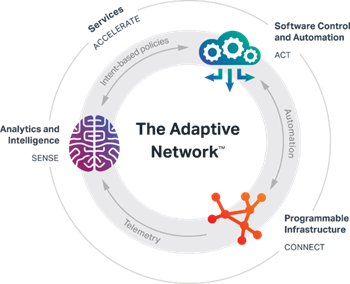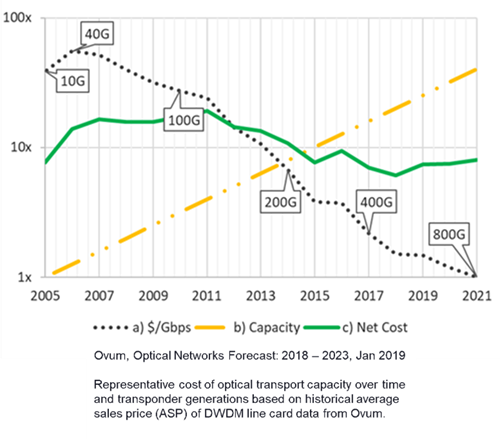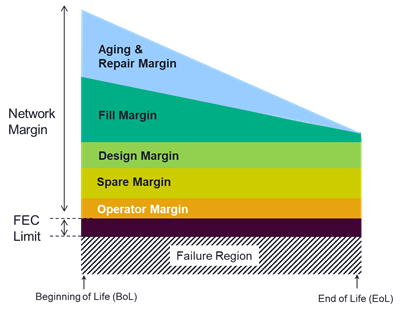Optical Network Expert Series: How near-zero margin networking changes network economics
Today perhaps more than ever, there is an explosion in network demand, and although everyone wants more from their network providers, they are not necessarily willing to pay more. For network providers, the revenue that is generated from a fixed number of bits being transported has eroded as quickly as the demand has grown. Facing these challenging market dynamics, providers are evolving their networks to quickly respond to ever-increasing demands for network capacity, while looking at innovative ways to continue to drive down the cost per transported bit.
Thankfully, technology advances across both hardware and software are enabling the evolution to the Adaptive NetworkTM, that can adapt to changing network conditions or new operator-defined policies, to deliver increased scalability by leveraging unused network margin. What if network providers had tools at their fingertips to quickly extract more capacity from the optical transponders already deployed in their network?
 One approach towards enabling continued transport cost reduction is to fully utilize available network capacity, previously stranded by fixed modem capacity and conservative margin guard bands, by mining the available Signal-to-Noise (SNR) margin to a near-zero level. This solution relies on a programmable optical infrastructure comprised of flexible capacity modems with flexible line systems, that can respond to physical layer and network controls. But for providers to deploy a practical near-zero margin network, analytics and automation are also key ingredients: to collect real-time network data and turn it into actionable insights, using intuitive user interfaces and software automation to simplify overall network operations.
One approach towards enabling continued transport cost reduction is to fully utilize available network capacity, previously stranded by fixed modem capacity and conservative margin guard bands, by mining the available Signal-to-Noise (SNR) margin to a near-zero level. This solution relies on a programmable optical infrastructure comprised of flexible capacity modems with flexible line systems, that can respond to physical layer and network controls. But for providers to deploy a practical near-zero margin network, analytics and automation are also key ingredients: to collect real-time network data and turn it into actionable insights, using intuitive user interfaces and software automation to simplify overall network operations.
Maximizing capacity with coherent technology advancements Coherent technology innovation has been essential in driving transport cost reductions over the past several years. For example, this graph shows a representative analysis of the line card cost of network capacity over time and generations of transponder technologies, from 10G to 800G. The growth for this example network was taken as 1.26 times per year in capacity. This analysis shows that the cost per transported bit per second (the dotted line) has been dropping while the total demand for transport increases. The net cost for the total capacity (modems only) which corresponds to the green line, is obtained by multiplying these two quantities together. What is interesting to note is that the total cost remains relatively flat over time. In other words, modem technology innovations have reduced the cost per bit of transport at a rate that has been keeping pace with this level of demand.
Coherent technology innovation has been essential in driving transport cost reductions over the past several years. For example, this graph shows a representative analysis of the line card cost of network capacity over time and generations of transponder technologies, from 10G to 800G. The growth for this example network was taken as 1.26 times per year in capacity. This analysis shows that the cost per transported bit per second (the dotted line) has been dropping while the total demand for transport increases. The net cost for the total capacity (modems only) which corresponds to the green line, is obtained by multiplying these two quantities together. What is interesting to note is that the total cost remains relatively flat over time. In other words, modem technology innovations have reduced the cost per bit of transport at a rate that has been keeping pace with this level of demand.
Converting SNR margin into capacity
But how can this trend continue, as we get closer and closer to the Shannon Limit with each generation of coherent technology? Continuing to reduce the cost per bit of transport requires both programmable modems and advanced software applications, such that providers can closely match the capacity of a Layer 0 channel (or wavelength) to the actual system margin or specific SNR ratio required to traverse a specific path of the network. SNR is often expressed in dB units, so one can think of dBs as a scarce resource whose availability is determined by two factors:
- The physics of the route the channel is propagating through (fiber characteristics, linear and nonlinear noise, etc.)
- Customer-defined policies including aging and repair margins, end-of-life margins, and risk tolerance
The ‘channel capacity’-to-dB matching can be determined once during the network planning phase so capacity remains fixed once the channel is deployed or can be performed dynamically over the lifetime of the optical network. The latter takes advantage of the fact that dBs available to the channel can change over time, either due to new network conditions (changing span loss, increased wavelength fill) or new operator-defined policies.
Maximizing capacity with near-zero margin networks Today’s variable capacity coherent modems are designed to convert as much of this SNR into capacity as possible given network constraints on quality of service (QoS). Delivering near-zero margin networks takes advantage of additional margin that is available in the network but that is constrained against customer-defined policies as shown here in the diagram. Reclaiming this available SNR margin can significantly increase the capacity delivered by the network – in some cases (shorter distances) doubling the capacity of a channel!
Today’s variable capacity coherent modems are designed to convert as much of this SNR into capacity as possible given network constraints on quality of service (QoS). Delivering near-zero margin networks takes advantage of additional margin that is available in the network but that is constrained against customer-defined policies as shown here in the diagram. Reclaiming this available SNR margin can significantly increase the capacity delivered by the network – in some cases (shorter distances) doubling the capacity of a channel!
In this educational blog series, you will learn from the actual experts working to develop the hardware and software technology advancements required to achieve a near-zero margin network, with the goal of maximizing the delivered capacity of the transponders already deployed in the network. David Boertjes and David Côté share their insights on the design and deployment considerations behind this approach and how we may be delivering a practical near-zero margin network sooner than one may think.
Check out the other installments in the blog series:
- Part 1: Optical Network Expert Series: Designing programmable infrastructure to achieve near-zero margin networks by David Boertjes
- Part 2: Optical Network Expert Series: Leveraging network analytics for unprecedented control and monitoring by David Boertjes and David Côté
- Part 3: Optical Network Expert Series: Applying AI to maximize capacity and Quality of Transmission by David Côté
Or want to get a more in-depth understanding of this new approach now? Download the full paper "Practical Considerations for Near-Zero Margin Network Design and Deployment" today.


